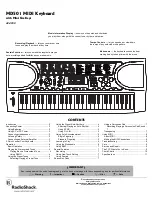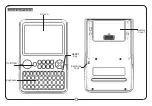
41
Oxford American Thesaurus of Current English
Guide to The Oxford American Thesaurus of Current English
HEADWORDS
The text of
The Oxford American Thesaurus of Current English is organized under
headwords, which are displayed in bold type. The headwords are listed in strict
alphabetical order.
Many English words have two or more acceptable spellings; in this dictionary, the
one used is the one regarded as being the most common. Occasionally, two
spellings share nearly equal usage; in such cases, the headwords include both
forms. For example:
cagey, cagy
adjective guarded, secretive, noncommittal,
cautious, chary, wary, careful, shrewd, wily ....
PARTS OF SPEECH
A headword is always followed by its part of speech. When a word has two or more
different parts of speech, it is listed more than once with separate entries for each.
For example:
obscure
adjective
1
obscure references: unclear, indeterminate,
opaque ....
obscure
verb
1
obscure the main issue: confuse, blur, muddle ....
Not all parts of speech of a word are necessarily included as headwords. For
example, many words that function as adjectives can also function as adverbs. In
such cases, the adverbial senses are included only when they have useful sets of
synonyms.
HOMOGRAPHS
Certain words have the same spelling but different meanings and different
etymologies (origins). Such words, known as homographs, are treated as separate
headwords, even when they have the same part of speech. For the purposes of
cross-referencing, homograph numbers are included in order to distinguish identical
headwords with the same part of speech. For example:
bank
1
noun
1
a grassy bank: slope, rise, incline ....
bank
2
verb bank an aircraft: tilt, slope, slant ....
bank
3
noun
1
borrow from the bank: financial institution;
commercial bank ....
If two or more headwords are identical in spelling but have different parts of
speech, homograph numbers are not used. This does not necessarily imply that
these entries share the same etymology.
ENTRIES
Each entry contains a list of words that are synonyms of the headword: i.e., the
words can be used in place of the headword in most (although not all) contexts.
When a word has more than one meaning, the different senses of the word are
numbered. In many instances, example phrases (followed by symbol) indicate the
particular sense and illustrate the use of the word. In some cases, two or more
examples are given; these are separated by a vertical bar (|). For example:
contribute
verb
1
contribute money/time to the charity | happy
to contribute: give, donate, hand out ....
Note that a slash (/) is used to separate alternative words in order to save space.
The slash applies only to the two words it separates; thus “contribute time/money”
can be read as “contribute time” and “contribute money”.
SUBENTRIES
Verb phrases are included as subentries (in bold type) under a main entry. For
example:
chance
verb
1
it chanced that they arrived last: happen, occur,
take place, come about, ....
2
have to chance it: risk, hazard,
gamble, ....
chance on/ upon
chance upon an old friend |
chanced on the answer: come across, meet, stumble on, come
upon, encounter;
inf. bump into, run into.
PWE350_introToDict0707.pm65
07/09/2004, 15:52
41
Black
Содержание PW-E350
Страница 23: ...21 to specify the and e detailed view creen 0 times by 07 09 2004 15 51 ...
Страница 30: ...MAL the See page e Auto al form 04 7 29 4 29 PM ...
Страница 45: ...29 43 07 09 2004 15 51 ...
Страница 48: ...ECTRONICS CORPORATION za Mahwah New Jersey 07430 1163 PRINTED IN CHINA 04GGK TINSE0783EHZZ 07 09 2004 15 51 ...






































